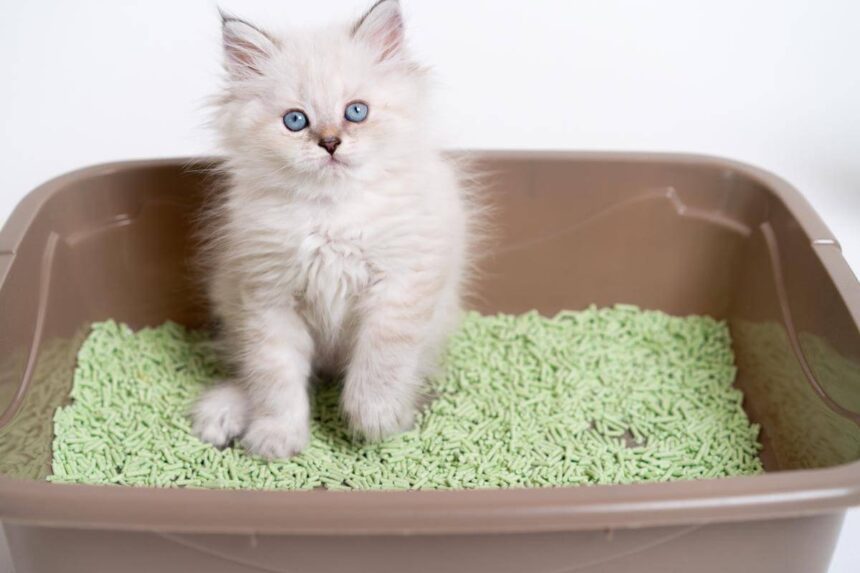Can dry cat food cause constipation? A lot of cat owners have questions about whether or not dry food can cause constipation.
The simple answer is that yes, it can. Dry food does not have the same moisture content as wet food, which can lead to dehydration, and cause constipation.
If your cat is eating dry food and you notice that they are having trouble going to the bathroom, it might be a good idea to switch them to a wet food diet or add some water to its dry food.
In this detailed guide, we’ll dive deep into this issue, explore the pros and cons of dry cat food, and offer practical tips to keep your cat’s digestive system in top shape.
Understanding Cat Constipation
Before we jump into whether dry cat food is the culprit, let’s get a handle on what constipation actually is. Simply put, constipation is when your cat has infrequent or difficult bowel movements. This can lead to discomfort, pain, and more serious health issues if left untreated. Signs of constipation include:
- Straining to poop
- Small, hard, dry stools
- Decreased appetite
- Lethargy or reduced activity
- Bloated abdomen
Why Does Constipation Happen?
Constipation in cats can be caused by a variety of factors. It’s not always about the food. Here’s a quick rundown:
- Dehydration: Not enough water intake can make the stools hard and difficult to pass.
- Diet: Low fiber diets or changes in diet can impact bowel movements.
- Lack of Exercise: Cats need to move to keep their digestive systems active.
- Medical Issues: Underlying health problems like megacolon, obstructions, or even arthritis can cause constipation.
- Stress: Changes in environment, routine, or even a dirty litter box can stress your cat and lead to constipation.
The Role of Dry Cat Food
Moisture Content
One of the main differences between dry and wet cat food is moisture content. Dry cat food has significantly less moisture, typically around 10%, compared to wet food, which can have up to 78% moisture. This lower moisture content can lead to dehydration, especially if your cat isn’t drinking enough water on its own.
Fiber Content
Dry foods often contain more fiber than wet foods. Fiber is important for digestion, but the type and amount of fiber matter. Insoluble fiber helps add bulk to stools, while soluble fiber can help stools pass more smoothly. Too much or too little of either can cause problems.
Ingredients and Additives
Some dry cat foods contain fillers, artificial flavors, and preservatives that might not agree with every cat’s digestive system. These ingredients can contribute to constipation or other digestive issues.
Can Dry Cat Food Cause Constipation?
The short answer is: Yes, it can. But it’s not the sole factor. Every cat is unique and reacts differently to food. Some cats thrive on dry food without any issues, while others may struggle with constipation. Here are some reasons why dry cat food might cause constipation:
Dehydration
Cats are not natural water drinkers. In the wild, they get most of their hydration from their prey. When on a dry food diet, they might not drink enough water to compensate for the low moisture content in the food, leading to dehydration and constipation.
Low-Quality Ingredients
Some dry foods use low-quality ingredients or fillers that are harder for cats to digest. These can include grains or by-products that don’t provide the necessary nutrients and can cause digestive upset.
Lack of Variety
A diet consisting solely of dry food might lack the variety needed for a balanced diet. Including wet food or raw food can provide more moisture and different nutrients that help keep the digestive system functioning properly.
Tips to Prevent Constipation in Cats
If you’re feeding your cat dry food and worried about constipation, there are several strategies you can try:
Increase Water Intake
Encourage your cat to drink more water. Use a pet water fountain, as many cats prefer running water. You can also try adding water or broth to their dry food to increase moisture intake.
Mix in Wet Food
Adding wet food to your cat’s diet can help increase their moisture intake. Even a small amount of wet food can make a big difference in preventing constipation.
High-Fiber Diet
Ensure your cat’s diet has enough fiber. Look for dry foods that are specifically formulated to support digestive health. Adding a small amount of canned pumpkin (plain, not the pie filling) can also boost fiber intake.
Regular Exercise
Keep your cat active. Play with them regularly to encourage movement, which helps stimulate their digestive system.
Regular Vet Check-Ups
Regular check-ups with your vet can help catch any underlying health issues that might be contributing to constipation. Your vet can also provide personalized dietary advice.
What Food Helps a Constipated Cat?
If your cat is already constipated, certain foods can help alleviate the issue:
Canned Pumpkin
Pumpkin is high in fiber and can help add bulk to your cat’s stool, making it easier to pass. Mix a small amount into their regular food.
Wet Cat Food
Switching to a wet food diet can significantly increase your cat’s moisture intake, helping to soften stools and promote regular bowel movements.
Fiber-Rich Foods
Foods with added fiber, like certain prescription diets or high-fiber dry foods, can help regulate your cat’s digestive system.
Probiotics
Probiotics can support a healthy gut microbiome, which is crucial for proper digestion. You can find probiotic supplements specifically for cats.
How Can You Tell If a Cat Is Constipated?
Knowing the signs of constipation can help you catch the issue early and take action:
- Litter Box Habits: If you notice your cat straining or spending more time in the litter box without producing stool, they might be constipated.
- Stool Appearance: Small, hard, and dry stools are a clear sign of constipation.
- Behavioral Changes: A constipated cat might show signs of discomfort, such as avoiding the litter box, decreased appetite, or lethargy.
- Physical Signs: A bloated or firm abdomen can indicate constipation.
Is Wet Food Better for Cats with Constipation?
In many cases, wet food is better for cats prone to constipation. Here’s why:
Higher Moisture Content
Wet food naturally contains more moisture, which helps keep your cat hydrated and their stools softer.
Easier to Digest
Wet food is often easier to digest, which can help prevent digestive issues like constipation.
Nutrient-Rich
Many wet foods are packed with high-quality ingredients that provide essential nutrients, promoting overall health.
Which Dry Cat Food Is Best for Constipation?
If you prefer to stick with dry food but want to prevent constipation, look for high-quality, high-fiber options. Here are a few recommendations:
Royal Canin Gastrointestinal Fiber Response Dry Cat Food
This food is designed specifically for cats with digestive issues. It’s high in fiber and contains easily digestible ingredients.
Hill’s Science Diet Adult Sensitive Stomach & Skin Dry Cat Food
Formulated for cats with sensitive stomachs, this food is high in fiber and free from artificial additives.
Blue Buffalo Basics Limited Ingredient Diet Grain-Free Turkey & Potato Formula Dry Cat Food
A grain-free option that is limited in ingredients, making it suitable for cats with sensitivities or allergies. It’s high in protein and fiber, promoting healthy digestion.
Is Your Cat Constipated? A Vet Explains How to Help
Homemade Cat Food for Constipation
If you’re up for a little DIY, making homemade cat food can be a great way to ensure your cat gets a balanced diet with the right nutrients to prevent constipation. Here are some ingredients to consider:
Lean Meats
Chicken, turkey, or fish can be good protein sources. Make sure to cook them thoroughly to avoid any risk of bacteria.
Vegetables
Certain vegetables, like pumpkin or sweet potatoes can add fiber and moisture to your cat’s diet. Always cook them thoroughly and mash them up.
Bone Broth
Adding a little bone broth to your cat’s meals can increase their moisture intake and provide essential nutrients.
Supplements
Consider adding probiotics or omega-3 supplements to support your cat’s digestive health.
How to Make a Cat Poop When Constipated?
Sometimes, even with the best diet and hydration, a cat might still get constipated. Here are some steps you can take:
Encourage Hydration
Ensure your cat drinks plenty of water. Use a pet fountain or offer fresh water multiple times a day.
Add Fiber
Incorporate high-fiber foods like pumpkin into their diet. You can also use fiber supplements designed for cats.
Gentle Exercise
Encourage your cat to play and move around. Gentle exercise can help stimulate their digestive system.
Laxatives
In some cases, your vet might recommend a mild laxative or stool softener. Always consult your vet before giving your cat any medication.
What Can I Give My Cat for Constipation?
There are several safe options to help relieve your cat’s constipation:
Canned Pumpkin
A natural source of fiber, canned pumpkin can help regulate your cat’s digestive system. Mix a small amount into their food.
Miralax
This over-the-counter laxative can be mixed with water and given to your cat. Always consult your vet for the correct dosage.
Olive Oil
A teaspoon of olive oil added to your cat’s food can help lubricate their intestines and ease stool passage.
Laxatone
A flavored gel that helps relieve constipation by lubricating the intestines. It’s available over the counter at pet stores.
Conclusion
So, can dry cat food cause constipation? Yes, it can, but it’s not the only factor at play. Ensuring your cat stays hydrated, gets enough fiber, and has a balanced diet is key to preventing constipation. Whether you choose dry food, wet food, or a combination of both, paying attention to your cat’s individual needs is essential. Keep an eye on their litter box habits, provide plenty of water, and consult your vet regularly to keep your cat happy and healthy.



